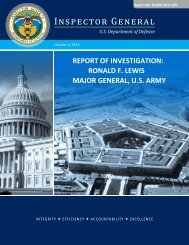Command Red Team
2gWzzvB
2gWzzvB
Create successful ePaper yourself
Turn your PDF publications into a flip-book with our unique Google optimized e-Paper software.
<strong>Red</strong> <strong>Team</strong> Activities<br />
i. The following red team techniques, along with those described elsewhere in this<br />
chapter, have proven effective in the production of critical reviews.<br />
(1) ACH. ACH seeks to identify alternative explanations (hypotheses) and<br />
evaluate all evidence that will disprove, rather than confirm, existing hypotheses. ACH<br />
can help overcome cognitive limitations, especially the tendency for new information to<br />
be interpreted in ways that reinforce hidden assumptions and existing paradigms and to<br />
overlook, discount, or misinterpret new information that might contradict preconceived<br />
notions. This technique compares different hypotheses against the supporting evidence<br />
for each. The objective is to evaluate the strength and consistency of the evidence for<br />
each theory in order to judge the strength of each hypothesis. A structured matrix can be<br />
used to simplify a review of the analysis. This systematic examination of the evidence<br />
makes the technique especially useful for deception detection. It can also show when<br />
observed evidence is actually consistent with multiple hypotheses, thus highlighting areas<br />
for future analysis. If ACH suggests that current hypotheses are inconsistent with<br />
available evidence, then the red team should explore the implications of the other<br />
hypotheses that seem more consistent with the facts.<br />
(2) Indicators. The red team should periodically review events and trends<br />
within the OE to identify early signs of fundamental change and provide warning. These<br />
signs may consist of new factors that alter or negate existing paradigms and operating<br />
assumptions, or that alter the relative strengths or relationships between existing factors<br />
within the OE. Indicators may be found in evolving diplomatic or economic conditions,<br />
new governmental or non-governmental organizations, changing social or political<br />
dynamics, rising charismatic leaders, military or paramilitary modernization, new<br />
technologies, etc. The red team may also create lists of observable events or “tipping<br />
points” that may set conditions for or precede a radical change in the situation or OE.<br />
Such lists can be used to sensitize analysts to subtle, incremental, seemingly-unrelated<br />
incidents that could presage dramatic change in the OE. Overall, identifying signposts of<br />
change can reduce the risk of surprise by guarding against “boiling the frog,” the paradox<br />
of expertise, and other biases that can inhibit the ability of an analyst or organization to<br />
recognize impending revolutionary change.<br />
(3) High Impact/Low Probability Analysis. Analysis is used to assess how<br />
rare, random, or unlikely events may have dramatic effects on the OE, and to estimate the<br />
potential scope of such effects. The same analysis can also be used to assess the impact<br />
of localized events or tactical operations on the strategic environment (e.g., videos of<br />
unprofessional behavior by individual Service members that lead to global outrage and<br />
loss of support for US policy). <strong>Red</strong> teams may assist planners by estimating future high<br />
impact/low probability events that could complicate the execution of a plan or otherwise<br />
have major consequences for future operations. Analysis can help counter complacency<br />
and overconfidence, which may lead staffs and policymakers to unconsciously assume<br />
their plans will be executed exactly as planned, without any interference by the OE, the<br />
adversary, or other relevant actors. High impact/low probability analysis reminds<br />
analysts and planners that there is no guarantee that the adversary will select the plan’s<br />
IV-7



